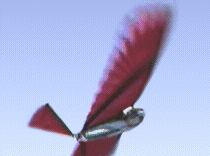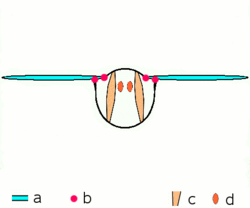Flapping counter-torque

Flapping counter-torque is used by both birds and insects which produces asymmetrical flapping to turn. The outer wing flaps faster on the down stroke going into the turn and at the same time the inner wing flaps faster during the up stroke, which creates the turning motion.[1]
On April 10, 2009, Tyson L. Hedrick, Bo Cheng, and Xinyan Deng released their research findings on the dynamics of turning and maneuverability during flight pertaining to flying animals in the report, Wingbeat Time and the Scaling of Passive Rotational Damping in Flapping Flight.[2]
The researchers recorded the flight of hummingbirds and hawkmoths using 1,000 frame-per-second video cameras. The research expanded to four other kinds of flying insects, two species of birds and a bat which all use the exactly the same quantity of wing beats to complete a turn in mid-flight.[3] The flying animals just returned to regular wing flapping to resume a straight course of flight.
The speed of the wing beating increased the animal's ability to maneuver and stabilise in flight.[4]
"Now that technology has developed to the point where detailed measurements of flapping manoeuvres have become feasible, a world of comparative research is opening," Bret Tobalske, Missoula biomechanicist at the University of Montana said, "The results will inform all future research into maneuvering flight in animals and biomimetic flying robots," such as micromechanical flying insects MIF, flytech dragonflies, entomopters and ornithopters.[5]
The study involved researchers from the Department of Biology, University of North Carolina and the Department of Mechanical Engineering, University of Delaware, Newark.
References
- ↑ Brandon Bryn (April 9, 2009). "Science: Maneuverability and Stability Are Birds of a Feather". American Association for the Advancement of Science.
- ↑ "Birds do it, and now we know how". CBC News. April 10, 2009.
- ↑ Karen Hopkin (April 10, 2009). "Birds and Bugs Use Same Flight Manual". Scientific American Inc.
- ↑ Randolph E. Schmid, (April 9, 2009). "Scientists start to unlock secrets of bird flight". The Associated Press.
- ↑ "Secret Law of Flying Could Inspire Better Robots". Suiniyi.com. April 10, 2009.
External links
- Bio-robotics Lab, University of Delaware Aerodynamics of Flexible Wings
- Wingbeat Time and the Scaling of Passive Rotational Damping in Flapping Flight
